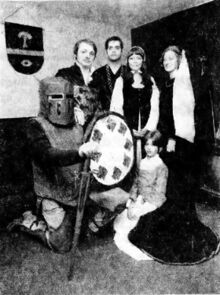History of Eamon
The history of Eamon is nearly as long as the history of the personal computer itself, extending from the game's origins in Des Moines in the 1970s, through its growth and expansion in the 1980s and 1990s, through the rise of new ports in the 2000s, to ongoing development in the 2010s and 2020s. The game, along with the many adventures, clubs, newsletters, websites, and variants that it's inspired, is the product of hundreds of imaginative creators, and this article summarizes the history of their efforts.
This article is under construction.
Origins and influences
The influences that inspired and shaped Eamon range from role-playing games to works of literature, real-world connections and organizations, and a variety of computer technologies and software, and extend back decades before the game's creation in 1979. Like most contemporary fantasy-themed creations, a significant early influence is the legendarium of J. R. R. Tolkien whose works established many of the features and patterns of the modern fantasy genre. Tolkien's The Hobbit (1937) and The Lord of the Rings (1954–1955) built a rich and complex world inhabited by wizards, dwarves, elves, hobbits, dragons, and orcs, in which heroes undertake difficult missions through far-off lands and dangerous dungeons, features that would be incorporated into numerous subsequent works of fantasy by many other creators including Brown.
The nature and behavior of magic in Eamon has its roots in the works of Jack Vance, a writer of science fiction and fantasy whose Dying Earth series (1950–1984) introduced a system of rules-based magic often known as "Vancian Magic". Key features of the system are that magical effects are invoked by distinct spells, each one creating a single specific effect, and that those casting the spells cannot do so indefinitely but may "run out" of the ability to cast them and have to recharge.
Though these and other writers shaped the fantasy landscape that Brown's game ultimately built upon, the more immediate and significant influence on Eamon was a project that drew together features of Tolkien, Vance, and others into a tabletop role-playing game: Dungeons & Dragons, a popular fantasy RPG system created by Gary Gygax and Dave Arneson first published in 1974, with the more sophisticated Advanced Dungeons & Dragons following in 1977. The game married the fantasy genre with a detailed system of rules for character creation and combat that allowed groups of participants to play the parts of noble heroes, warriors, and mages fighting monsters in magical worlds. D&D included materials describing settings and scenarios for these players to adventure in, but within the game's framework they could also create their own stories, opening endless possibilities for creative players to enjoy.

Des Moines resident Bill Fesselmeyer was one such player who became a fan of D&D. Bill and his wife Sherry Fesselmeyer, who together founded the Des Moines chapter of the Society for Creative Anachronism in 1978, were friends with Donald Brown, then a student from Colorado studying actuarial science at Drake University, and introduced him to the game. Bill conceived the idea of a computer-based version of D&D and encouraged Brown, an aspiring programmer, to create one. Brown not only understood D&D but was also familiar with some early computer-based games that were similar in certain ways to what Bill envisioned, notably Colossal Cave Adventure developed by Will Crowther and Don Woods in the mid-to-late 1970s, and took inspiration from them. (Brown would later refer to some of his adventures as "A Class" in honor of Crowther and Woods' game.) Though it lacked the character development and role-playing features of D&D, Colossal Cave Adventure's command-and-response interface for moving, interacting with objects, checking inventory, and performing other actions provided a useful template, and Brown set to work developing his own system.
The result was the first version of the non-commercial text adventure game The Wonderful World of Eamon, which Brown coded in Applesoft BASIC for the Apple II computer sometime in 1979. Fredrik Ekman, operator of the first Eamon fan website, quotes Brown describing how the game got its name: "I had a dictionary, one of those huge ones with a thesaurus, mini encyclopedia, and at the end was a list of names. I opened that section, put my finger down, and it landed on Eamon."
Early years (1979–1983)
Computer Emporium and early growth
Brown first unveiled his Eamon game system in late 1979 or very early 1980 at the Computer Emporium, a computer supply store on Douglas Avenue in Des Moines where he liked to spend time and later worked. Jim Jacobson, another computer enthusiast employed there, recalls that the Emporium ran a small Apple II computer club with meetings that he, Brown, and some others attended, and at one such meeting Brown introduced Eamon. At the time it consisted of the master disk and two adventures, The Beginners Cave and The Lair of the Minotaur, plus an early version of the Eamon Dungeon Designer. "All of us were floored," Jacobson recalls.
Impressed, Jacobson quickly used the Dungeon Designer to create his own adventure, The Cave of the Mind, then wrote several more: The Zyphur Riverventure, The Devil's Tomb, The Abductor's Quarters, and The Quest for Trezore. Brown meanwhile added Castle of Doom, Assault on the Clone Master, and The Tomb of Molinar, and adapted his "Star Wars Adventure" into the Eamon adventure The Death Star.
As non-commercial free software, Eamon could be distributed without restriction; copies of the master and the completed adventures were shared through the Computer Emporium and its Apple II club and quickly appeared elsewhere. Geoffrey Genz recalls that copies of the first two disks (the master and Minotaur) were available at a computer club in Denver in Brown's home state of Colorado by mid-1980, and that he and his friend Paul Braun, both high school students at the time, created their adventure The Caves of Treasure Island later that same year. Another early adventure, The Magic Kingdom, was created by David Cook.